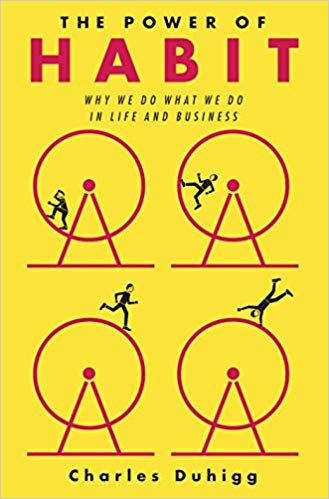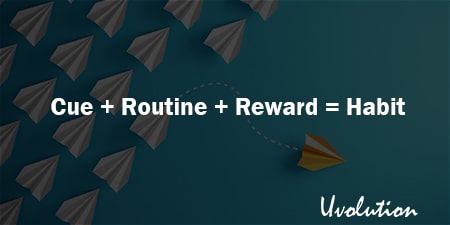The Power of Habit by Charles Duhigg Book Summary
The Book in 1 Sentences
The Power of Habit: Why We Do What We Do in Life and Business
“This book draws on hundreds of academic studies, interviews with more than three hundred scientists and executives, and research conducted at dozens of companies.
It focuses on habits as they are technically defined: the choices that all of us deliberately make at some point, and then stop thinking about but continue doing, often every day.
At one point, we all consciously decided how much to eat and what to focus on when we got to the office, how often to have a drink or when to go for a jog. Then we stopped making a choice, and the behavior became automatic. It’s a natural consequence of our neurology. And by understanding how it happens, you can rebuild those patterns in whichever way you choose.” ~ Charles Duhigg
9 BIG Ideas
2. Cue + Routine + Reward = Habit
6. Exercise is a keystone habit
The Power of Habit Book Summary
1. Why habits are formed?
“Habits, scientists say, emerge because the brain is constantly looking for ways to save effort. Left to its own devices, the brain will try to make almost any routine into a habit, because habits allow our minds to ramp down more often.
This effort-saving instinct is a huge advantage. An efficient brain requires less room, which makes for a smaller head, which makes childbirth easier and therefore causes fewer infant and mother deaths.
An efficient brain also allows us to stop thinking constantly about basic behaviors, such as walking and choosing what to eat, so we can devote mental energy to inventing spears, irrigation systems, and, eventually, airplanes and video games.”
2. Cue + Routine + Reward = Habit
“This process within our brains is a three-step loop. First, there is a cue, a trigger that tells your brain to go into automatic mode and which habit to use. Then there is the routine, which can be physical or mental or emotional. Finally, there is a reward, which helps your brain figure out if this particular loop is worth remembering for the future.”
3. Choose a simple cue
“If you want to start running each morning, it’s essential that you choose a simple cue (like always lacing up your sneakers before breakfast or leaving your running clothes next to your bed) and a clear reward (such as a midday treat, a sense of accomplishment from recording your miles, or the endorphin rush you get from a jog).
But countless studies have shown that a cue and a reward, on their own, aren’t enough for a new habit to last. Only when your brain starts expecting the reward—craving the endorphins or sense of accomplishment—will it become automatic to lace up your jogging shoes each morning. The cue, in addition to triggering a routine, must also trigger a craving for the reward to come.”
4. The keystone habit
“It wasn’t the trip to Cairo that had caused the shift, scientists were convinced, or the divorce or desert trek. It was that Lisa had focused on changing just one habit—smoking—at first.
Everyone in the study had gone through a similar process. By focusing on one pattern—what is known as a “keystone habit”—Lisa had taught herself how to reprogram the other routines in her life, as well.”
“Where should a would-be habit master start? Understanding keystone habits holds the answer to that question: The habits that matter most are the ones that, when they start to shift, dislodge and remake other patterns.”
5. Believe change is possible
“How do habits change? There is, unfortunately, no specific set of steps guaranteed to work for every person. We know that a habit cannot be eradicated—it must, instead, be replaced.
And we know that habits are most malleable when the Golden Rule of habit change is applied: If we keep the same cue and the same reward, a new routine can be inserted. But that’s not enough. For a habit to stay changed, people must believe change is possible. And most often, that belief only emerges with the help of a group.”
"“I wouldn’t have said this a year ago—that’s how fast our understanding is changing,” said Tonigan, the University of New Mexico researcher, “but belief seems critical. You don’t have to believe in God, but you do need the capacity to believe that things will get better.”"
“The evidence is clear: If you want to change a habit, you must find an alternative routine, and your odds of success go up dramatically when you commit to changing as part of a group. Belief is essential, and it grows out of a communal experience, even if that community is only as large as two people.”
6. Exercise is a keystone habit
“When people start habitually exercising, even as infrequently as once a week, they start changing other, unrelated patterns in their lives, often unknowingly.
Typically, people who exercise start eating better and becoming more productive at work. They smoke less and show more patience with colleagues and family. They use their credit cards less frequently and say they feel less stressed.
It’s not completely clear why. But for many people, exercise is a keystone habit that triggers widespread change. “Exercise spills over,” said James Prochaska, a University of Rhode Island researcher. “There’s something about it that makes other good habits easier.””
7. Grit
“Cultures grow out of the keystone habits in every organization, whether leaders are aware of them or not. For instance, when researchers studied an incoming class of cadets at West Point, they measured their grade point averages, physical aptitude, military abilities, and self-discipline.
When they correlated those factors with whether students dropped out or graduated, however, they found that all of them mattered less than a factor researchers referred to as “grit,” which they defined as the tendency to work “strenuously toward challenges, maintaining effort and interest over years despite failure, adversity, and plateaus in progress.””
8. Willpower is the most important keystone habit
“Dozens of studies show that willpower is the single most important keystone habit for individual success. In a 2005 study, for instance, researchers from the University of Pennsylvania analyzed 164 eighth-grade students, measuring their IQs and other factors, including how much willpower the students demonstrated, as measured by tests of their self-discipline.
Students who exerted high levels of willpower were more likely to earn higher grades in their classes and gain admission into more selective schools. They had fewer absences and spent less time watching television and more hours on homework.
“Highly self-disciplined adolescents outperformed their more impulsive peers on every academic-performance variable,” the researchers wrote. “Self-discipline predicted academic performance more robustly than did IQ. Self-discipline also predicted which students would improve their grades over the course of the school year, whereas IQ did not.…
Self-discipline has a bigger effect on academic performance than does intellectual talent.” And the best way to strengthen willpower and give students a leg up, studies indicate, is to make it into a habit.”
9. Decide to change it!
“Hundreds of habits influence our days—they guide how we get dressed in the morning, talk to our kids, and fall asleep at night; they impact what we eat for lunch, how we do business, and whether we exercise or have a beer after work.
Each of them has a different cue and offers a unique reward. Some are simple and others are complex, drawing upon emotional triggers and offering subtle neurochemical prizes. But every habit, no matter its complexity, is malleable.
The most addicted alcoholics can become sober. The most dysfunctional companies can transform themselves. A high school dropout can become a successful manager. However, to modify a habit, you must decide to change it.
You must consciously accept the hard work of identifying the cues and rewards that drive the habits’ routines, and find alternatives. You must know you have control and be self-conscious enough to use it—and every chapter in this book is devoted to illustrating a different aspect of why that control is real.”
“Once you understand that habits can change, you have the freedom—and the responsibility—to remake them. Once you understand that habits can be rebuilt, the power of habit becomes easier to grasp, and the only option left is to get to work.”
That was my QUICK summary of the great book The Power of Habit by Charles Duhigg. If you’re interested, get your copy. There is a HUGE amount of life-changing ideas in this book, and we’ve only touched on a tiny bit of it.
Buy The Book: The Power of Habit by Charles Duhigg

GET Blinkist 7 Days FREE Trial
3000+ Book Summaries
(Audio and Text)








